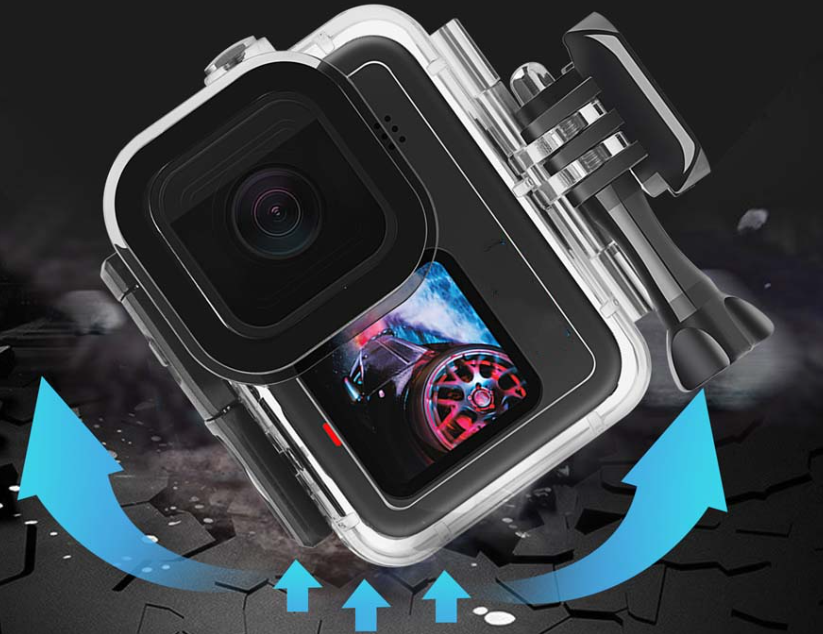
Action cameras have become indispensable tools for capturing thrilling moments during various outdoor activities. To ensure the longevity and optimal performance of these devices, many users opt for action camera protectors. Full-coverage action camera protectors offer comprehensive protection by covering the entire camera body, including the lens, ports, and buttons. While these protectors provide extensive coverage, they also have their pros and cons. This essay will discuss the advantages and disadvantages of using a full-coverage action camera protector to help users make an informed decision when choosing a protector for their valuable device.
I. Pros of Using a Full-Coverage Action Camera Protector:
- Enhanced Protection: Full-coverage action camera protectors offer comprehensive protection to the entire camera body. They shield the camera from impacts, drops, scratches, and other hazards. By covering all vulnerable areas, including the lens and buttons, these protectors provide peace of mind and increase the overall durability of the camera.
- Added Waterproofing: Some full-coverage protectors are designed to be waterproof, providing an additional layer of defense against water damage. These protectors often feature seals or gaskets that prevent water from entering the camera body, allowing users to capture footage in wet or underwater environments. Waterproof full-coverage protectors are particularly beneficial for water sports or underwater photography.
- Dust and Dirt Resistance: Full-coverage protectors create a barrier that prevents dust, dirt, and debris from infiltrating the camera’s crevices and sensitive components. This feature is especially advantageous in dusty or sandy environments, such as desert terrains or off-road activities. By keeping the camera clean, these protectors contribute to maintaining the camera’s optimum performance and minimize the need for frequent cleaning.
- Extended Lifespan: The comprehensive protection offered by full-coverage action camera protectors can significantly extend the lifespan of the camera. By shielding the device from impacts, scratches, and environmental factors, these protectors help maintain the camera’s functionality and aesthetics over time. This extended lifespan translates into cost savings, as users can avoid or delay the need for expensive repairs or the purchase of a new camera.
- Resale Value: Using a full-coverage protector can help preserve the camera’s condition and appearance, thus increasing its resale value. Potential buyers are more likely to choose a camera that has been well-protected and maintained. The comprehensive protection offered by full-coverage protectors enhances the camera’s appeal in the second-hand market, potentially fetching a higher price when it comes time to sell or upgrade.
II. Cons of Using a Full-Coverage Action Camera Protector:
- Bulk and Weight: Full-coverage action camera protectors tend to be bulkier and heavier compared to other types of protectors. The added material required to cover the entire camera body can increase the overall size and weight of the camera setup. This additional bulk and weight may impact portability and hinder freedom of movement during outdoor activities.
- Limited Accessibility: Full-coverage protectors may impede access to buttons, ports, and controls on the camera. While some protectors have precise cutouts or button covers, others may require removing or adjusting the protector to access specific features. This limitation in accessibility can be inconvenient, especially when quick and easy control access is necessary in dynamic shooting situations.
- Heat Dissipation Issues: Full-coverage protectors can potentially affect the camera’s heat dissipation capabilities. Action cameras generate heat during operation, and the design of full-coverage protectors may hinder proper airflow, trapping heat within the camera body. This can lead to overheating issues, which may affect the camera’s performance or cause damage over time.
- Display Visibility: Some full-coverage protectors may compromise the visibility of the camera’s display. Although protectors are typically designed to be transparent, certain angles or lighting conditions can create reflections or glare, inhibiting clear visibility of the screen. This limitation can pose challenges when framing shots or reviewing footage on the camera’s display.
- Compatibility Issues: Full-coverage protectors are often designed to fit specific camera models. This limited compatibility can be a disadvantage for users who frequently switch between different camera models or want the flexibility to use their protector with various devices. It is essential to ensure that the chosen protector is compatible with the specific camera model to avoid compatibility issues and potential damage.
Conclusion: Using a full-coverage action camera protector offers several advantages, including enhanced protection, added waterproofing, dust and dirt resistance, extended lifespan, and improved resale value. However, it is important to consider the cons associated with these protectors, such as bulk and weight, limited accessibility, potential heat dissipation issues, display visibility limitations, and compatibility concerns. By carefully weighing the pros and cons, users can make an informed decision about whether a full-coverage action camera protector is the right choice for their specific needs and preferences. Ultimately, the decision should be based on the level of protection required, the intended usage scenarios, and the user’s willingness to sacrifice some convenience









